Travelling with Tribal Tracks is a wonderful experience. They take care of everything and you don't have to worry about anything!
Gordon G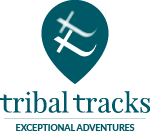
Location
Difficulty
Accommodation and Meals
Teahouse, Hotel
Duration
12 days
Meeting Point
Kathmandu
Annual Leave
8 days
Group Size
Up to 14
Seasons
March, April, October to start of December
Walking Distance
60km approx
Meet Charlie, a director of, and one of the co-founders of Tribal Tracks.
Trek into the Annapurna Sanctuary, in Nepali, the Annapurna Deuthali an amphitheatre of huge Himalayan peaks.
Reach the the 'base camp' of Machhapuchhare, even though there is technically no such thing as climbing of this sacred mountain is prohibited.
Wonder at the view of the near vertical south face of Annapurna (8091m) from Annapurna base camp (4130m), realising that you are little more than half way to the height of its summit!
Experience wonderful Nepali hospitality, culture and food in the teahouses along the way.
Take time to explore the wonders of Kathmandu.
All the info you need
Trip Details
The route to Annapurna Base Camp is a spectacular trek, traversing a huge variety of terrain. From glacial moraine to rice terraces, outstanding high mountain views are guaranteed at all times.
The Annapurna Region in central Nepal is the most geographically and culturally diverse region for trekking and is also an area of conservation and sustainable development.
Stretched over 2600 square km, the area has a variety of diverse cultures, tribes and castes such as the Brahmins, Chettris, Newars, Gurungs, Magars, Manangies and the Tibetans. This area has sub-tropical lowlands, valleys, bamboo, oak and rhododendron forests, alpine meadows, windswept desert plateaus and the towering Annapurna Mountains. This area also has the world’s deepest river gorge, Kali Gandaki, lying some 6900-metres/22,563 ft below some of the world's largest and most beautiful mountains as Annapurna I (the 8th highest in the world) & Fishtail (Machhapuchhare - considered to be one of the most beautiful and holy mountains).
Animals and birds are in abundance in this region. 440 species of birds and animals like the marten, deer, langur and the elusive snow leopard live in this area. Whether it is culture, wildlife or hard core trekking that you are after, this epic adventure will not disappoint!
Please note that single supplements are not available in the teahouses on the trek.
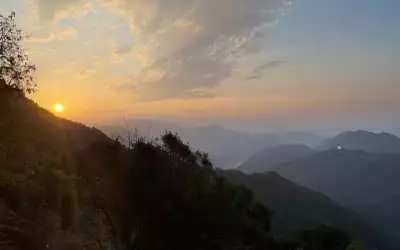
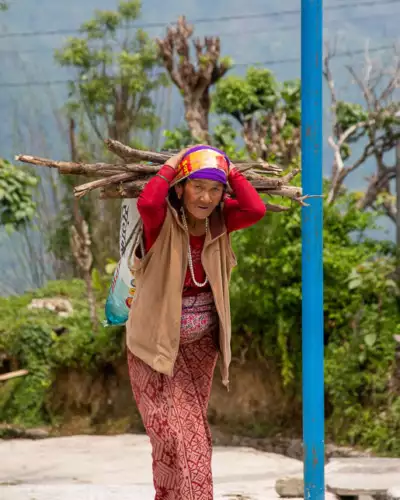

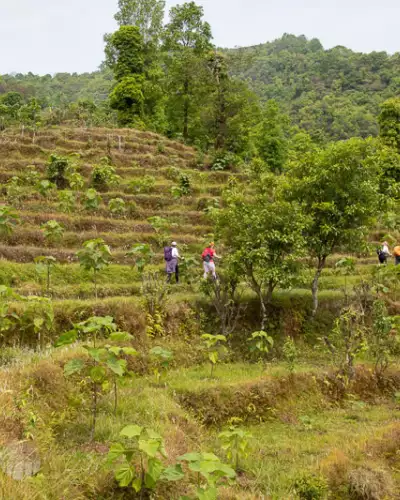
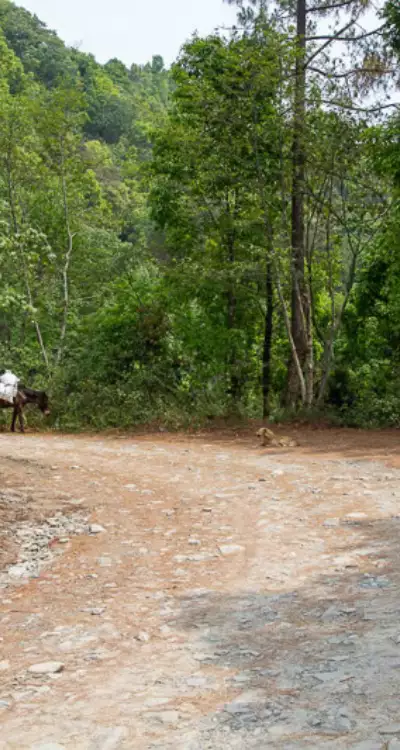
Trip Details
"I am extremely grateful to Tribal Tracks for all their hard work and support to make this such an amazing experience from start to finish. It could not have been better!" - Debs, 2023
Departing from the UK, you meet your Tribal Tracks leader at the airport, before beginning your journey to Kathmandu.
When you arrive in Kathmandu, you will be met by our local team and will be transferred to your hotel. If you arrive in the morning, you will have lunch, then there will be time to explore Kathmandu in the afternoon. After dinner in the evening, there will be a full trek briefing, so you will be ready for what lies ahead!
Accommodation and Meals
Overnight Hotel Mulberry, Kathmandu (or similar) dinner.
It is a very early start today to leave for the airport for the 30 minute flight from Kathmandu to Pokhara.
On the flight, if the weather is clear, we should enjoy spectacular aerial views of the Annapurna range and the Kathmandu valley. Pokhara is in central Nepal, standing on the edge of the enormous Phewa Lake, and is well known as a gateway to the Annapurna range.
We will drive to Kimche, which can take up to two hours, depending on the traffic. After our early start, we will take a short hike to Ghandruk village, which is no more than two hours away.
Ghandruk is the second largest Gurung settlement in Nepal. It's surrounded by neatly terraced fields and provides fantastic views of Annapurna South and Machhapuchhare. We find our first teahouse for the night.
Trek distance (approx) 3km
Accommodation and Meals
Overnight in teahouse, full board. 3km trekking distance.
Trek distance (approx) 10km/5-6hrs trekking
We set off on a thrilling descent through a vast rhododendron forest, where the towering trees create a natural tunnel bursting with colour in season and alive with birdsong year-round. The path twists and turns beneath the canopy before suddenly opening up to reveal sweeping views of beautifully terraced fields carved into the hillsides—classic Himalayan scenery at its finest.
From here, the trail begins to climb, leading us uphill for around 5km past waterfalls that tumble down rock faces. Eventually, we arrive at one of Nepal's many iconic suspension bridges—high walkways that link valleys and ridgelines.
After crossing the bridge, we continue to Chomrong, a stunning village perched just beneath the colossal Annapurna massif. Here, the views are nothing short of breathtaking: Annapurna South towers ahead in all its glory, while the sacred peak of Machapuchare (Fishtail Mountain) pierces the sky. It's a magical reward for the day's effort.
Accommodation and Meals
Overnight in teahouse, full board.
Trek distance (approx) 9 km / 7 hours.
After breakfast, we begin our descent toward a suspension bridge that stretches over the Chomrong Khola—an exhilarating start to the day. From there, we climb steadily up the opposite side of the valley, the trail weaving through terraced hillsides and into the peaceful hamlet of Banuwa.
Our journey continues to the charming village of Sinuwa (2,340m), nestled among dense, emerald forests and dramatic Himalayan scenery. From Sinuwa, we trek for around an hour to reach Khuldi Ghar (2,477m), where the landscape begins to feel wilder and more remote.
The trail then dips downwards, winding through trees and chirping birdlife, until we arrive at Bamboo (2,340m). With its cluster of lodges and tranquil setting, it’s the perfect spot to stop and refuel over lunch. As its name implies, Bamboo marks the gateway to a towering forest of—yes—bamboo.
After lunch, we press on, climbing gently but steadily toward Dovan. This stretch marks our first steps into the sacred Annapurna Sanctuary. Surrounded by soaring trees and the whispering hush of the forest, we end the day with a sense of true adventure as we reach our accommodation nestled deep in this natural wonderland.
Accommodation and Meals
Overnight in teahouse, full board.
Trek distance (approx) 7.7km / 4-5 hours.
Soon after Dovan we will enter the sacred forest of Jode Yehm, where, near the waterfall on the east bank of the Modi Khola (river), you will see an altar surrounded by thousands of white banners suspended from the trees with signs advising tourists how to respect the local deity
A sign asks trekkers not to carry eggs or meat beyond this point, out of respect for the local deity, Baraha Than. From Dovan, it will take an hour to reach Himalayan Hotel (2,840m).
Passing several spectacular waterfalls which cascade down the opposite side of the Modi Khola, we then climb through bamboo forest to reach Hinku Cave at 3100m. The trail crosses the remnants of a glacier just beyond Hinko, then climbs through large boulders until we reach the small settlement of Deurali (3140m) where we will spend the night.
Accommodation and Meals
Overnight in teahouse, full board. 7.5km/4 hours trekking
Trekking Distance (approx) 9.2 km / 6-7 hours.
After breakfast, we begin trekking to the base camp of Machhapuchhre (Fishtail Mountain).
It will take around 3 hours to get there, trekking between Machhapuchhre and Hiunchuli - the symbolic 'Gates' into the Sanctuary. The views are stupendous; the panorama includes Hiunchili, Annapurna South, Annapurna I, Annapurna III (7555m), Gangapurna (7454m) and of course, the ever-present Machhapuchhre.
We continue to Annapurna Base Camp (ABC), which is only two to three hours away from Machhapuchhare Base Camp. Except for a few hills, the route goes quite gradually up and the walk is pleasant. We reach ABC, where we will spend the night, and you can take some time to explore. Slightly further above ABC, the path leads to a small hill, which is the best point to admire the entire panorama of the Annapurna Sanctuary. You can also admire the near-vertical south face of Annapurna, which was climbed in 1970 by Chris Bonington, and is still renowned as an exceptional expedition. You can also walk past the porter shelter to a prayer-flag draped viewpoint on the moraine for a spectacular view over the glacier. Nearby is a stone Buddhist monument to the well-known climber Anatoli Boukreev, who was killed in 1997 by an avalanche.
Accommodation and Meals
Overnight teahouse, full board.
Trekking Distance (approx) 11km/ 6 hours trekking |
After breakfast, we being trekking again, and follow the track going back through rhododendron forest and climbing up and down to Sinuwa.
We then cross the Chommrong Khola (river) and climb up to Chhomrong village (2060m). From here, after a short climb, the track descends down through stone paths to Jhinnu Danda. This will be our last night in a teahouse and we can relax and enjoy our surroundings and the hospitality.
Accommodation and Meals
Overnight teahouse, full board.
Trekking Distance (approx) 2km/1 hour trekking
After breakfast, we begin our final leg of the trek.
We hike down to one of the longest suspension bridges in the area and then continue to walk through small settlements and farmland, until we reach our 4WD vehicles that are waiting for us at Methque. We then drive to Pokhara and check into our hotel, where we can enjoy a hot shower and change out of trekking clothes!
Accommodation and Meals
Overnight Hotel Barahi, Pokhara (or similar) full board.
We have an early breakfast before heading to the airport for our return flight to Kathmandu.
Upon reaching Kathmandu, we will check in to our hotel and freshen up, before having lunch in a local restaurant. The rest of the afternoon is at leisure to explore and do some shopping, before coming together in the evening for some drinks and a slap up celebration meal in another local restaurant.
Accommodation and Meals
Overnight in Hotel Mulberry, Kathmandu (or similar) full board including a celebration meal.
After breakfast, cram in some last minute shopping or sightseeing before departing for the airport and your flight home.
Enjoy the final views of the Himalaya as the plane flies down the Kathmandu valley towards the Ganges delta, and reflect on what you have achieved.
Accommodation and Meals
Breakfast.
Trip Details

| From/To | Nights | Total Cost (includes non-refundable deposit) | Non-refundable Deposit |
Single supplement | Places | Enquiry | |
|---|---|---|---|---|---|---|---|
| Oct 16, 2026 Oct 27, 2026 |
11 | £1995 (excludes flights) | £500 | £200 | Available |
Trip Details
Please see detailed information on visa requirements on this link Nepalese Visas.
In a nutshell, almost everything!
This is what you will need to buy/source yourself.
It is important that you read the itinerary carefully, and take account of the rating we have given it.
Although our challenges are not technical, they do require a good degree of physical fitness. The conditions will require stamina and strength, which you should recognise and train for. This will be a much better experience if you are fit and prepared. You should feel comfortable walking 6-8 hours per day.
In setting the maximum size of our groups, we take a number of factors into account.
Altitude, degree of difficulty, the terrain, the climate and time of year, all determine the maximum group size. Sometimes it will be 20, sometimes it will be 8-14, but safety is always our priority.
You will be accompanied by a Tribal Tracks UK Leader, Mountain Leader qualified, as well as supported by our local, in-country guides.
It is a requirement of Tribal Tracks booking terms and conditions that each supporter must hold their own travel insurance, which covers the trip and the activities they are doing. Read more here.
We advise you to put insurance in place as soon as possible, ideally on booking so you are covered immediately. Your insurance must be valid and in date, covering the entire period that you are travelling for, including the return journey home. It should cover medical and personal accident risks, and should include repatriation costs and air ambulance or helicopter rescue services, where appropriate.
Tribal Tracks has 100% Financial Protection and has a trust account with the Protected Trust Service, member number 5566.
This means that all client monies paid to Tribal Tracks are held in our dedicated trust account, which is supervised by an independent trustee. This means that in the very unlikely event that Tribal Tracks ceases to trade, your money is safe. For more information, please visit this link. Any flights booked for you by Tribal Tracks will be ATOL-protected under our own ATOL certificate.
Tribal Tracks considers the safety of all of its participants and staff to be a top priority, and as such we have thorough safety systems in place.
In the event of an injury, we have an evacuation plan in place for all elements of the trek route. We do ask that you look after yourself during the trek in the following way, as this will help avoid unnecessary problems:
We know that the unexpected can happen.
While you are away, things can happen at home and people may need to get in contact with you. This can be tricky when you are in remote areas. So, shortly before departure, we provide you with an Emergency Procedure document to distribute to your nearest and dearest. This sets out how to contact Tribal Tracks and the steps Tribal Tracks will then take to get in contact with you.
It is really important that you are well prepared for your physical challenge and that you are confident that you will be able to fully participate.
Although our leaders are well trained to deal with different capabilities, if they have any concerns about someone’s ability to safely partake in the trek, or their impact on other people’s enjoyment, we authorise them to take necessary action which, in some circumstances, may involve asking someone to step out of the trek. Although this is a very rare occurrence, by booking this trip you agree to section 11 of our Booking Conditions which clearly states that our leaders have the authority to do this. In these circumstances, we will ensure anyone sitting out is safely provided for and offered alternative options where possible. Refunds will not be provided for activities missed and customers may be liable for additional costs incurred.
At Tribal Tracks, Responsible Travel is enormously important to us, and our commitment to responsible travel is evidenced in every itinerary that we prepare.
Core to our business is the belief that holidays can and should be enjoyable to the traveller but should be conducted in a socially, environmentally and economically responsible manner which brings benefit to local communities. This is implemented through a variety of measures which can be found in our Responsible Travel policy. We encourage you to read this and to play your own part in travelling responsibly.
Trip Details
Trip Details
The trek is a challenge. We will be walking for a long time over sometimes challenging terrain with steep ascents and descents.
The best way to build endurance fitness is to start with some gentle walks and gradually build up both the distance and duration over the next few months. In the last 2 months, we would recommend to go out and do long days, ideally in the hills, to build up the strength in your legs. About a week before the trek, limit any training to short walks – you want to have fresh legs at the start!
For the trek you should be comfortable trekking between 6 - 8 hours per day, but remember we have all day to achieve the distances and will not be going at racing snake pace. It may sound obvious, but make sure that you are walking properly, hitting the ground with your heel first, then rolling onto your toe, which pushes you onto the next step (this will help reduce the risk of shin splints and tendon pulls). Walk with your head up, eyes forward and shoulders level.
It is a good idea to develop a level of cardiovascular fitness (exercising and strengthening your heart and lungs). This comes from running, cycling or swimming for between 20 minutes and an hour, and will really help develop your endurance fitness. Three sessions a week is normally advised, increasing time and distance over time.
Replicate conditions in training i.e., use all the kit you will be using and try your walking poles if you want to use them.
It is important to pack so that you know where everything is. Separating kit into different packing cubes, or even plastic bags can really help with this. You can pack by item (eg socks and pants in one cube, tops in another etc) or by day, putting your entire outfit for that day together in one place. Taking an extra bag or cube to separate dirty kit is a great idea.
Teahouses are lodges in Nepal. They are wonderful places to meet other trekkers and usually have cosy, communal dining rooms with a good choice of local food. Some sell beer, soft drinks and some basic snacks such as Pringles and chocolate bars. The sleeping accommodation is usually basic, with twin share, or sometimes triple share rooms, with beds, bedding and pillows, but we suggest you take your own sleeping bag. The rooms are usually not heated, and while they will have electricity, the supply can be intermittent. There are usually charging facilities in the dining room if you cannot charge your phone in your room. There is usually a mix of squat and Western toilets, and while there may be a shower, it is better not to depend on this. Please note that single supplements are not available in teahouses as all rooms are shared, usually by 2-3 people, but they can also be dormitory style rooms.
You will have two bags on the trip - your main bag and your back pack.
You should operate on the basis that you will not have access to your main bag during the day and while you are trekking. This means that it is important to have everything you need in your back pack. Waterproofs should go in the bottom, together with an extra layer, sunscreen and sunglasses, plus hat and gloves (if you are in a colder climate). You should also have your water bottles, and any specific snacks, medicines or first aid items you want to take, such as zinc tape and blister plasters. Baby wipes/toilet roll and nappy sacks are also essential for going to the toilet while you are trekking - we will explain more in the pre-departure briefing!
We will brief you in the pre-departure briefing as to the catering specifically for your trip. However, as a guide, each morning you will be provided with a very filling local breakfast, usually accompanied by tea or coffee. Lunch will be during your trek and will be prepared by the team of cooks or we will utilise local restaurants or teahouses. Food will always be ample and tasty. If wild camping, dinner will be in the dining tent and will be traditional, freshly prepared food. If you are staying in a hotel or teahouse, dinner will be served there. Water, tea and coffee will be served and alcohol will usually not be available, although there will be some exceptions. We will provide 4 litres of drinking water per person per day. You will need to fill up 2 litres at breakfast and another 2 litres at lunchtime.
Please ensure that you have notified us before departure if you have any specific dietary requirements or allergies as we can cater for most.
Please inform us of any dietary requirements or allergies before you travel, and preferably at the time of booking. We can cater for almost all diets, but only if we know about them beforehand.
Sleeping bags are designed to work by trapping your body heat in the down surrounding you. If you wear lots of layers, your body heat will not be able to escape as effectively, and you will be cold. Wearing a thin thermal layer is ideal. It does sound counter intuitive, but we promise that it works!
Putting your clothes for the next day in the bottom of your sleeping bag will also help with warmth, as it will fill up any spare space around your feet, and it will mean your clothes are nicely warmed up in the morning.
If you find it difficult to sleep without a pillow, we recommend that you take a travel pillow and a regular pillowcase with you. Put your pillow in the pillow case, and use your down jacket/layers to fill out the pillowcase, you will end up with a pretty decent pillow!
And as for stuff or roll when it comes to packing your bag away? We are very much in the stuff camp! Read more here.
In the event of an injury, we have an evacuation plan in place for all elements of the trek route. We do ask that you look after yourself during the trek in the following way, as this will help avoid unnecessary problems:
There will be early morning starts, typically around 0600 - 0700hrs, so that the team can set off on the trek in good time. It is important that you pack up your kit before breakfast and leave your bag outside your tent or accommodation so that the crew can load them onto the jeeps and/or mules. There will be a freshly cooked lunch provided on your trek route. The aim is to get into camp before sunset if possible, when you can enjoy a hot drink and snacks. It is important that you change into your thermals and put layers on when you get into camp as the temperatures can drop sharply and you need to keep warm.
In the morning, the Tribal Tracks leader will wake up the group. When you hear the call, please begin to get ready, and pack all your kit away in your 'main bag' before breakfast. Put this bag outside your tent or accommodation as the crew can then begin to break down the tents/load the luggage. Ensure that you have all that you need in your backpack for the day, as you will not have access to your main bag until the next camp (see 'What do I put in my backpack?).
When you arrive into camp, it is important to get changed into different clothes, usually the ones that you will be wearing the next day. Even if you have had dry weather, you will have been sweating, and your clothes will be damp. As the sun sets and the air cools, you will quickly feel cold. Before this, you will want to freshen up and we recommend the 'baby wipe bath'. As there are no showers while on the trek, having a freshen up with a baby wipe will help keep you clean and will make you feel much better, before you put your clean clothes on. Unpack your sleeping bag and get everything out that you need for nighttime, such as your warm hat, jacket, head torch and book. Sort out your back pack for the next day by removing rubbish and replenishing snacks etc.
Doing this before dinner will mean you can get into your sleeping bag quickly, when it is likely to feel cold.
For up-to-date vaccinations information please visit the NHS website ‘Fit for Travel’ at: http://www.fitfortravel.nhs.uk. The Tribal Tracks team are travel professionals, but we are not medical experts, and we would encourage you to visit your GP or travel nurse to discuss vaccination requirements. Please remember to take your itinerary with you so that they can see where you will be travelling. You should make an appointment at least 3-4 months before you travel.
In addition, please note that information on vaccinations can change at short notice; we recommend that you contact your Medical Professional or a Travel Health Clinic at least 8 weeks prior to departure for the most up to date information.
We recommend that you bring a multi-region adapter plug with you. There will be no facility to recharge electrical items on the trek, so we recommend you bring a power bank to top up the charge. We also recommend putting your phone on Airplane mode during the day to save on power.
Using your mobile overseas can sometimes attract unwelcome, very high tariffs. We recommend that you check with your network provider before you travel, but if in doubt, keep your phone switched to Airplane mode and use it only when there is WiFi. Reception can also be patchy, and unreliable, particularly in remote areas, which is why we carry a satellite phone with us. Please let your nearest and dearest know about this, and warn them that you may not be able to be in regular contact.
We ask that your luggage is kept to the absolute minimum. We will tell you the weights that you should not exceed, but usually, your main bag should not exceed 23kgs in weight.
It is important that you wear, or take your trekking boots with you in your hand luggage on the flight, as they are vital for the trek and cannot be replaced in the event of lost luggage.
We recommend leaving behind items such as high value jewellery, watches etc. Your passport and money should be always kept on you.
Trekking at high altitude (generally above 2500 metres) involves additional risk not normally associated with lower level treks. This is not something that should prevent you from undertaking a trek to our higher destinations, but it makes sense to learn about the dangers inherent in trekking at high altitude and also the ‘golden rules' to prevent Acute Mountain Sickness (AMS).
For each of our trips, you can find the maximum altitudes listed on the web site and in the itineraries. You should read the itinerary carefully and use your own judgement to gauge whether your chosen trip is suitable for your level of experience. If you have any doubts at all you should contact us and we are happy to discuss the trip with you.
You can acclimatise to altitude by the process known as acclimatisation. The most important rule is to gain height slowly and it is generally accepted that the maximum safe altitude gain in any one day is 500 metres once above 2500 metres. Where this is not possible, then it is important to have a rest or acclimatisation day at the new altitude before gaining further height. All our itineraries follow this rule. In general the maxim ‘climb high and sleep low' applies. It is perfectly acceptable (and even beneficial to your acclimatisation) to climb higher than 500 metres above your last camp (for example when crossing a high pass) as long as the increase in sleeping altitude remains within the above rule. All of our itineraries are carefully designed to build in optimum acclimatisation.
There is a link between daily fluid intake and successful acclimatisation and you must pay particular attention to hydration during trekking at high altitudes. On treks to 3000 metres and above most people will need to drink between 5 and 6 litres each day to achieve suitable hydration levels and you must adopt a responsible approach to achieving this target. It goes without saying that as alcohol is a diuretic, it is not recommended that you drink alcohol while at altitude.
Before embarking on a trek to high altitude it is important that you familiarise yourself with the signs and symptoms of Acute Mountain Sickness (AMS) and that you report any illness to your tip leader straight away. See the links at the bottom of this page for further reading on AMS.
There are a number of untested herbal remedies which claim to prevent mountain sickness. However, only one drug is currently known to have a useful role in preventing AMS and to be safe for this purpose: acetazolamide (Diamox). We recommend that you carry Diamox in your first aid kit for treks where you spend an extended period above 4000m. Diamox can only be obtained from a medical professional on prescription and it is important that you first consult your own doctor so that you know there are no contra indications with other medicines you may be taking and that you do not have an allergy to acetazolamide. Diamox commonly causes some minor side effects, such as tingling fingers and toes, or a metallic taste in the mouth, but more severe reactions are rare. On trek, the decision whether or not and when, you should take Diamox as with any drug, will rest solely with you. If you intend to take Diamox, you must familiarise yourself with the appropriate dosage and regime prior to coming on the trip. The links at the bottom of this page will provide further information on the use of Diamox as an aid to acclimatisation.
Travelling to high altitudes is not something you need to be scared of. Every year thousands of people enjoy the most amazing experiences in the world's greatest mountain ranges. Altitude sickness is entirely preventable if you follow the very simple rules and procedures detailed above. Please make sure you are aware of these before you travel. However, please be assured that we have emergency procedures in place in the event that someone does experience AMS.
For further reading on the above issues we recommend the following websites:
http://www.altitude.org/altitude_sickness.php
Trip Details
Nepal is a fascinating country and it is tempting to stay on to explore more of it. If you would like us to arrange this for you, just get in touch.
Have a question about Tribal Tracks? Get in touch, our small team will be delighted to help.